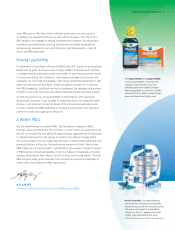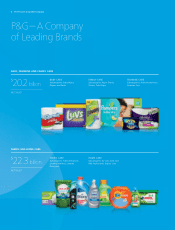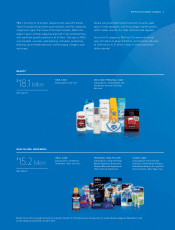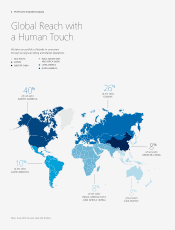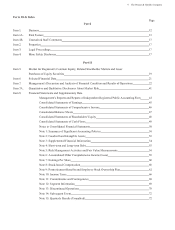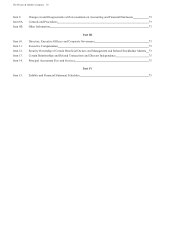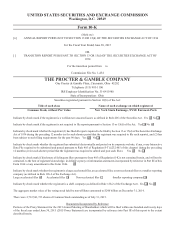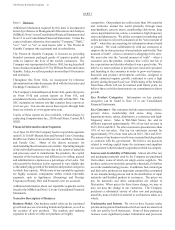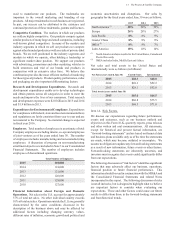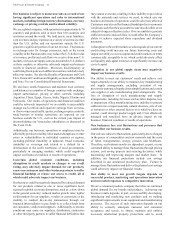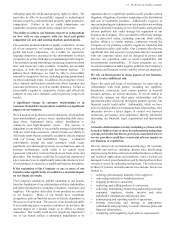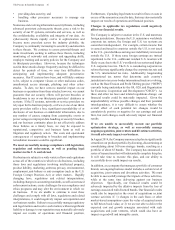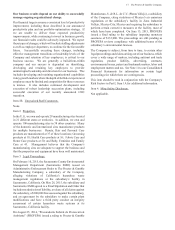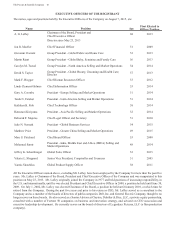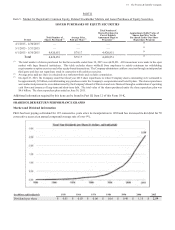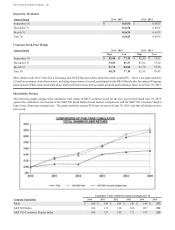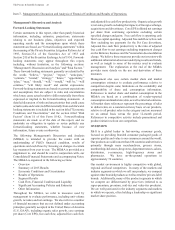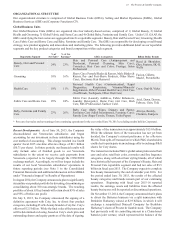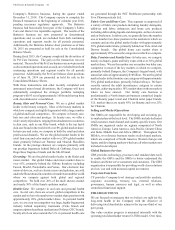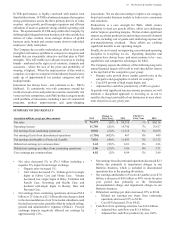Proctor and Gamble 2015 Annual Report Download - page 17
Download and view the complete annual report
Please find page 17 of the 2015 Proctor and Gamble annual report below. You can navigate through the pages in the report by either clicking on the pages listed below, or by using the keyword search tool below to find specific information within the annual report.15 The Procter & Gamble Company
infringing upon the intellectual property rights of others. e
must also be able to successfully respond to technological
advances made by, and intellectual property rights granted to,
competitors. Failure to do so could compromise our
competitive position and adversely impact our results.
The ailit to achiee our usiness oecties is deendent
on how well we can comete with our local and gloal
cometitors in new and existing markets and channels.
The consumer products industry is highly competitive. Across
all of our categories, we compete against a wide variety of
global and local competitors. As a result, we experience
ongoing competitive pressures in the environments in which
we operate, as well as challenges in maintaining profit margins.
This includes, among other things, increasing competition from
mid- and lower-tier value products, including private-label
products, in both developed and developing markets. To
address these challenges, we must be able to successfully
respond to competitive factors, including pricing, promotional
incentives and trade terms. In addition, the emergence of new
sales channels and business models may affect customer and
consumer preferences as well as market dynamics. Failure to
successfully respond to competitive factors and effectively
compete in new sales channels could negatively impact our
results.
A significant change in customer relationshis or in
customer demand for our roducts could hae a significant
imact on our usiness.
e sell most of our products via retail customers, which include
mass merchandisers, grocery stores, membership club stores,
drug stores, department stores, salons, distributors, e-
commerce and high-frequency stores. Our success is
dependent on our ability to successfully manage relationships
with our retail trade customers, which includes our ability to
offer trade terms that are mutually acceptable and are aligned
with our pricing and profitability targets. Continued
consolidation among our retail customers could create
significant cost and margin pressure on our business, and our
business performance could suffer if we cannot reach
agreement with a key customer based on our trade terms and
principles. Our business could also be negatively impacted if
a key customer were to significantly reduce the inventory level
of our products or experience a significant business disruption.
If the reutation of the Coman or one or more of our
rands erodes significantl, it could hae a material imact
on our financial results.
The Company's reputation, and the reputation of our brands,
form the foundation of our relationships with key stakeholders
and other constituencies, including consumers, customers and
suppliers. The quality and safety of our products are critical
to our business. Many of our brands have worldwide
recognition, and our financial success is directly dependent on
the success of our brands. The success of our brands can suffer
if our marketing plans or product initiatives do not have the
desired impact on a brand's image or its ability to attract
consumers. Our results could also be negatively impacted if
one of our brands suffers a substantial impediment to its
reputation due to a significant product recall, product-related
litigation, allegations of product tampering or the distribution
and sale of counterfeit products. Additionally, negative or
inaccurate postings or comments on social media or networking
websites about the Company or one of its brands could generate
adverse publicity that could damage the reputation of our
brands or the Company. If we are unable to effectively manage
real or perceived issues, including concerns about safety,
quality, efficacy or similar matters, sentiments toward the
Company or our products could be negatively impacted and
our financial results could suffer. Our Company also devotes
significant time and resources to programs that are consistent
with our corporate values and are designed to protect and
preserve our reputation, such as social responsibility and
environmental sustainability. If these programs are not
executed as planned or suffer negative publicity, the Company's
reputation and financial results could be adversely impacted.
We rel on third arties in man asects of our usiness,
which creates additional risk.
Due to the scale and scope of our business, we must rely on
relationships with third parties, including our suppliers,
distributors, contractors, joint venture partners or external
business partners, for certain functions. If we are unable to
effectively manage our third party relationships and the
agreements under which our third party partners operate, our
financial results could suffer. Additionally, while we have
policies and procedures for managing these relationships, they
inherently involve a lesser degree of control over business
operations, governance and compliance, thereby potentially
increasing our financial, legal, reputational and operational
risk.
Areach of information securit, including a cersecurit
reach or failure of one or more ke information technolog
sstems, networks, hardware, rocesses, associated sites or
serice roiders could hae a material aderse imact on
our usiness or reutation.
e rely extensively on information technology (IT) systems,
networks and services, including internet sites, data hosting
and processing facilities and tools and other hardware, software
and technical applications and platforms, some of which are
managed, hosted, provided andor used by third-parties or their
vendors, to assist in conducting our business. The various uses
of these IT systems, networks and services include, but are not
limited to:
ordering and managing materials from suppliers
converting materials to finished products
shipping products to customers
marketing and selling products to consumers
collecting, transmitting, transferring and storing customer,
consumer, employee, vendor, investor and other
stakeholder information and personal data
summarizing and reporting results of operations
hosting, processing and sharing, as appropriate,
confidential and proprietary research, business plans and
financial information
complying with regulatory, legal and tax requirements


